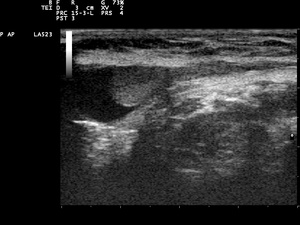Cryptorchidism
| Cryptorchidism | |
|---|---|
 |
|
| Classification and external resources | |
| Specialty | medical genetics |
| ICD-10 | Q53 |
| ICD-9-CM | 752.5 |
| OMIM | 219050 |
| DiseasesDB | 3218 |
| MedlinePlus | 000973 |
| eMedicine | med/2707 radio/201 ped/3080 |
| MeSH | D003456 |
Cryptorchidism is the absence of one or both testes from the scrotum. It is the most common birth defect of the male genitals. About 3% of full-term and 30% of premature infant boys are born with at least one undescended testis. However, about 80% of cryptorchid testes descend by the first year of life (the majority within three months), making the true incidence of cryptorchidism around 1% overall. Cryptorchidism may develop after infancy, sometimes as late as young adulthood, but that is exceptional.
Cryptorchidism is distinct from monorchism, the condition of having only one testicle. The condition may occur on one or both sides; it more commonly affects the right testis.
A testis absent from the normal scrotal position may be:
About two-thirds of cases without other abnormalities are unilateral; most of the other third involve both testes. In 90% of cases an undescended testis can be felt in the inguinal canal. In a small minority of cases missing testes may be found in the abdomen or appear to be nonexistent (truly "hidden").
Undescended testes are associated with reduced fertility, increased risk of testicular germ cell tumors and psychological problems when the boy is grown. Undescended testes are also more susceptible to testicular torsion (and subsequent infarction) and inguinal hernias. Without intervention, an undescended testicle will usually descend during the first year of life, but to reduce these risks, undescended testes can be brought into the scrotum in infancy by a surgical procedure called an orchiopexy.
Although cryptorchidism nearly always refers to congenital absence or maldescent, a testis observed in the scrotum in early infancy can occasionally "reascend" (move back up) into the inguinal canal. A testis which can readily move or be moved between the scrotum and canal is referred to as retractile. The word is from the Greek κρυπτός, kryptos, meaning hidden ὄρχις, orchis, meaning testicle.
Cryptorchidism, Hypospadias, Testicular cancer and poor Semen quality make up the syndrome known as Testicular dysgenesis syndrome.
...
Wikipedia
